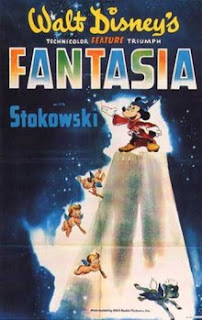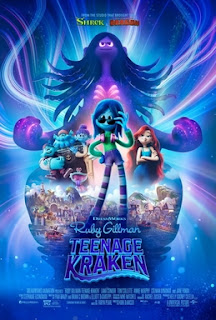Fantasia (1940)
Walt Disney strived to create some of
the best content when concerning animation. He stunned audience's
ears with 1928's “Steamboat Willie” becoming the first ever
cartoon with synchronized sound. He defied the movie industry with
the first ever feature length animated movie: “Snow White and the
Seven Dwarfs” in 1937. And in 1940, Disney did it again with two
features: “Pinocchio” and “Fantasia”. And while “Pinocchio”
may have been given appeal to families, “Fantasia” appeals to
everyone. While it may not have been a huge success during Walt's
time, in more recent years, the movie has gained quite a bit of
attention, mostly in part due to the artistry that went into making
the film a reality. Since its inception, “Fantasia” has been
regarded as Walt Disney's masterpiece; a very notable fact. In fact,
out of all of the animated films that the Disney company has
released, “Fantasia” is my personal favorite for reasons I will
explain below.
“Fantasia” is a masterpiece of
cinema. From creating stereo sound, to making a more modern
interpretation of Mickey Mouse, “Fantasia” defined what Disney
was capable of. It starts off with a collection of people sitting
down to perform an orchestration of great classical music under the
guidance of Leopold Stokowski. And from there, brilliance is
included.
The film is divided into eight unique
animated segments; each one standing out from the rest. Here they are
with a brief analysis of what they represent and mean.
First, Toccata and Fugue in D Minor by
Bach. After a brief interlude of the orchestra, the animators take
control and produce a series of abstract images that do not tell a
complete story. Lines and shapes take the stage, all of which
intertwine with the beautiful colors from all of the artists working
at the Disney studios. There is no real story; just let the eyes and
ears feast on the magic being presented before you.
Next, The Nutcracker Suite by
Tchaikovsky. A series of dances set to fantastical images, quite
literally. We see fairies, flowers, fish, and the mushrooms come to
life through magic, as unique and wonderful things happen. Starting
with fairies dancing on flowers just to make them look beautiful, the
scene transitions to dancing mushrooms, flowers performing ballet,
fish slowly dancing to music, Russian roses, and finally back to
fairies to turn autumn to winter in one of the most beautiful
transitions ever. This segment showcases the fantastical side of
nature, without showing a single nutcracker. This segment makes one
feel like they are at a concert in real life.
Next, The Sorcerer's Apprentice by Paul
Dukas. This is the most infamous segment of the entire program.
Mostly because, it features Mickey Mouse, and everybody knows him.
This one tells a more cohesive story- a young apprentice dabbles with
magic, and unfortunately cannot control it. Mickey Mouse is given a
better design, thanks to animator Fred Moore, and returns to the
mischievous mouse from the early days of his career. What else can be
said? The Sorcerer's Apprentice is something that everyone has seen,
and is pretty iconic. Also, the wizard in this segment is named Yen
Sid...
Next, we have the Rite of Spring by
Stravinsky. Here we see the evolution of Earth from its primordial
stages, all the way to the age of the dinosaurs. Here, we see how
terrifying early Earth was as interpreted by science and animation.
The dinosaurs might not be the most realistic when it comes to
interpretation, but the designs are truly worth noting. Plus, this
segment is the most mature out of all of them, and that is fine with
how things are represented here as the mature nature only brings up
more questions younger viewers may not have the answers to.
After a short intermission, we get some
fun with the soundtrack, and what sound looks like.
Soon, we get The Pastoral Symphony by
Beethoven. Here, we see a day in the life of several mythological
creatures, and some Greek gods. This is one of the more comical
segments, as the movements of the characters due have that cartoonish
feel to them. On top of this, the segment does contain the most
creativity that Disney's animators had conceived.
Next, it's Dance of the Hours by
Ponchielli. This is the most humorous segment out of the program.
Instead of having something serious, we are offered a collection of
animals dancing to various times of the day. We have ostriches,
hippopotamuses, elephants, and crocodiles representing various times
throughout the day. And it's all done via comedy and dance.
Finally, we have two very contrasting
pieces: Night on Bald Mountain by Mussorgsky and Ave Maria by
Schubert. On Night on Bald Mountain, we witness the demonic Chernabog
raise evil creatures to to watch them suffer for his own amusement.
Only until church bells ring out does the party end, and Ave Maria
comes with a group of religious individuals holding candles
signifying the sunrise. This is the darkest segment of the entire
program as there is a lot of dark elements present, and even some
scary images that might terrify younger viewers. However, with Ave
Maria, the darkness is taken away to bring forth calmness and
tranquility, and the short ends on an iconic view of the sunrise
thanks to the multiplane camera from Disney. This final segment makes
a bright contrast between light and dark in a very effective manner.
“Fantasia” uses all of these
segments to create a unique blend of music and animation. Nothing had
been done like this before, and it is hard to top it since. There had
been other films that have copied the style used in “Fantasia”,
like “Allegro Non Troppo” and this film's sequel “Fantasia
2000”, but nothing can top the original. “Fantasia” blends
animation and music so perfectly, it invented the modern music video
as we know it. The movie is a milestone in cinematic history, and it
should not be ignored.
Running at two hours long, the film can
be a bit slow at times. But as it is trying to emulate the feeling of
being at a concert, that it to be expected. The long run time is
needed for this type of film. It makes the viewer comfortable enough
to know that they will be in for a long time, and that they should
use their time wisely.
But of course, this is a movie where
the animation is the main star. Every segment has a different style
to it, and each one works effectively. There isn't a single segment
that looks out of place, nor do they feel dated. “Fantasia”
brings forth everything Walt Disney was trying to accomplish with his
team of animators in bringing the impossible to life. And they
succeeded.
In conclusion, “Fantasia” is an
ambitious project that Walt Disney made, that still holds up to this
day. Each piece of classical music is unique and stylized in their
own way, and each showcases various styles of animation. “Fantasia”
not only is a great Disney film, it's one of the best films period.




Comments
Post a Comment